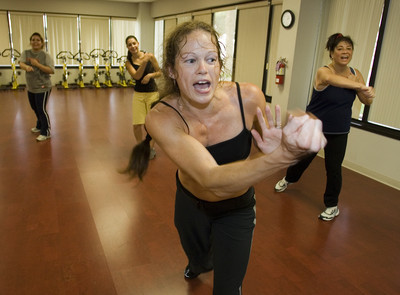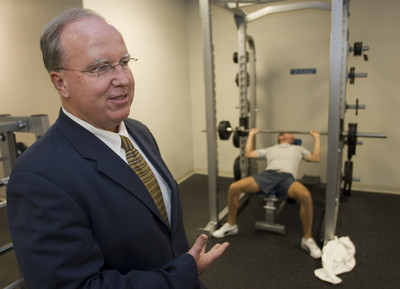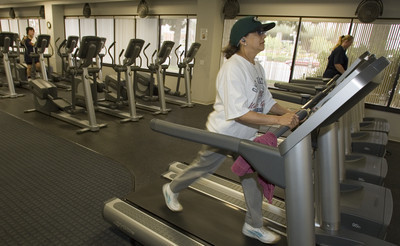Harrah’s after fiscal benefits of physical fitness



Spiraling health-care costs were becoming a major pain to Harrah’s Entertainment Chairman and Chief Executive Officer Gary Loveman.
He wanted a plan to slow the ever-growing medical bills his company and its employees were facing. So, he asked the company’s senior executives and benefits division to devise a two-pronged plan to help control costs while providing employees more and better services.
One of the results of this assignment is the $2.5 million Harrah’s Health and Wellness Center, which opened in January on Flamingo Road west of the Gold Coast.
The 7,000-square-foot medical clinic offers both urgent care and primary care, on the second floor of a former Las Vegas College building. The downstairs is a fitness center with 12,000 square feet of weights, treadmills and exercise rooms.
“Our employees have asked for high-quality health care at affordable rates,” said Loveman during the center’s opening. “This is both affordable and convenient.”
Only employees covered under Harrah’s health plan can use the medical clinic, but the fitness center is open to everyone who works at the company.
Shana Wiley, Harrah’s benefits manager, said the center’s mission is to help educate employees and keep them on track toward attaining their health goals.
“What we opened up here is to encourage those who weren’t going to the gym,” she said. “We wanted to make it more convenient for our employees to learn about exercise.”
Wiley said businesses are becoming more aware of fitness as they realize prevention efforts can help lower their health claims.
The fitness center also helps promote a healthier lifestyle for workers and cuts the company’s upfront medical costs, said Jeff Shovlin, Harrah’s vice president of benefits.
One of the biggest obstacles to getting the center launched was to show executives and the board how the company would see a return on its investment in the health center, Shovlin said.
When Harrah’s builds new hotel rooms, the return on investment is evident by measuring occupancy rates, and the value of a new casino or additional slots can be measured by looking at gaming revenue.
But, Shovlin said, the senior management had to understand that the center’s financial benefits may not be evident for three years or more.
Employees are taking advantage of the center.
The medical clinic, which is open six days a week, now averages 55 patients a day, up from about 38 when it opened.
The increase in traffic is coming from word-of-mouth referrals from fellow employees who have used the clinic, Wiley said. The facility is comparable to any family doctor’s office offering regular care, from checkups to nonemergency visits.
Patients who need urgent care are referred to an emergency room or another appropriate medical office.
The medical clinic was built for the 26,000 nonunion employees on the Harrah’s health plan.
Another 15,000 workers receive health care through pacts with Culinary Local 226 and Bartenders Local 165, but have to go through their own primary doctor.
Culinary officials visited the facility in July and Harrah’s has talked to executives from Aztar Corp. who wanted more information about the program. But other Las Vegas-based gaming companies have been hesitant about approaching Harrah’s to discuss the facility.
“Other gaming companies are a still a little skeptical about the return on investment,” Shovlin said.
Wiley, who held a similar position at Wynn Resorts Ltd., said the Harrah’s center is a new model for the gaming industry.
“Some places will have a fitness center or a nurses station,” Wiley said.
There is no timetable for the center to show some real “black and white” benefits or be shut down, Shovlin said.
“We think the economics are there,” Shovlin said. “There is no notion that there is going to be a drop-dead date where we’re going to have to show some return on investment. The return is intuitively there.”
Cleveland-based Whole Heath Management operates the center for Harrah’s, providing five full-time medical professionals for the clinic and staffing the fitness center. The medical staff can serve as an employee’s primary care doctor and the staff is available to treat minor ailments.
Whole Health also manages four other Harrah’s health centers around the country — Atlantic City, Lake Tahoe, New Orleans and Tunica, Miss.
Only Las Vegas and Atlantic City have the fitness center complementing a medical clinic.
Whole Health, which has 600 employees nationwide, has similar partnerships with Capital One, Continental Airlines, Scotts Miracle-Gro and various government agencies.
Having an outside operator helps maintain a barrier between the medical facility and the gaming company, said Dr. Phillip Zinni III, the center’s medical director.
The only data from the clinic that is shared with Harrah’s is nonidentifying information such as how many patients visit per day or how many patients have high blood pressure.
Zinni said he tries to make clear to patients he is not a company doctor for Harrah’s and that their information will be kept private.
Harrah’s began considering a clinic more than four years ago.
The gaming giant would not disclose particular numbers on company health care costs, but Shovlin said the numbers are similar to any large corporation with thousands of employees.
A healthy work force can boost a company’s bottom line, a study published in an April issue of the Archives of Internal Medicine suggests.
The study, conducted at the Duke University Medical Center, looked at obese individuals’ effect on workers’ compensation.
The study looked at 11,728 health care and university employees in various jobs at Duke for eight years through 2004.
Results showed that obese workers filed workers compensation claims at nearly twice the rate of employees who are not obese. Also, average medical claim costs per 100 employees were $51,091 for obese workers and $7,503 for nonobese workers.
The short-term disability claims costs per 100 employees increased to $59,178 for obese employees compared to $5,396 for nonobese employees.
Shovlin said the real cost savings are found in increased productivity through shorter doctor visits and a healthier work force.
“We are saving the company money through productivity savings,” he said. “It is very difficult to put a price tag on that.”
Shovlin said some of the longer-term savings come in the prevention of chronic illnesses such as stroke, which are also hard to measure.
“We have a skeptical management that wants to see black-and-white results,” Shovlin said. “They want a model that shows them a return on investment similar to the return they’ll get on other capital projects.”
Harrah’s attempt to cut medical costs on the front end comes while employee benefit costs continue to rise.
Employer premiums for medical care plans nationwide averaged $617.18 per month per participant for family coverage and $266.50 per month for single coverage, the Bureau of Labor Statistics at the U.S. Department of Labor reports.
Employee contributions to medical care premiums averaged $296.88 for family coverage and $76.05 for single coverage nationwide.
This story first appeared in the Business Press. Arnold M. Knightly writes for the Business Press’ sister publication, the Review-Journal. He can be reached at 477-3893 or at aknightly@review journal.com.












